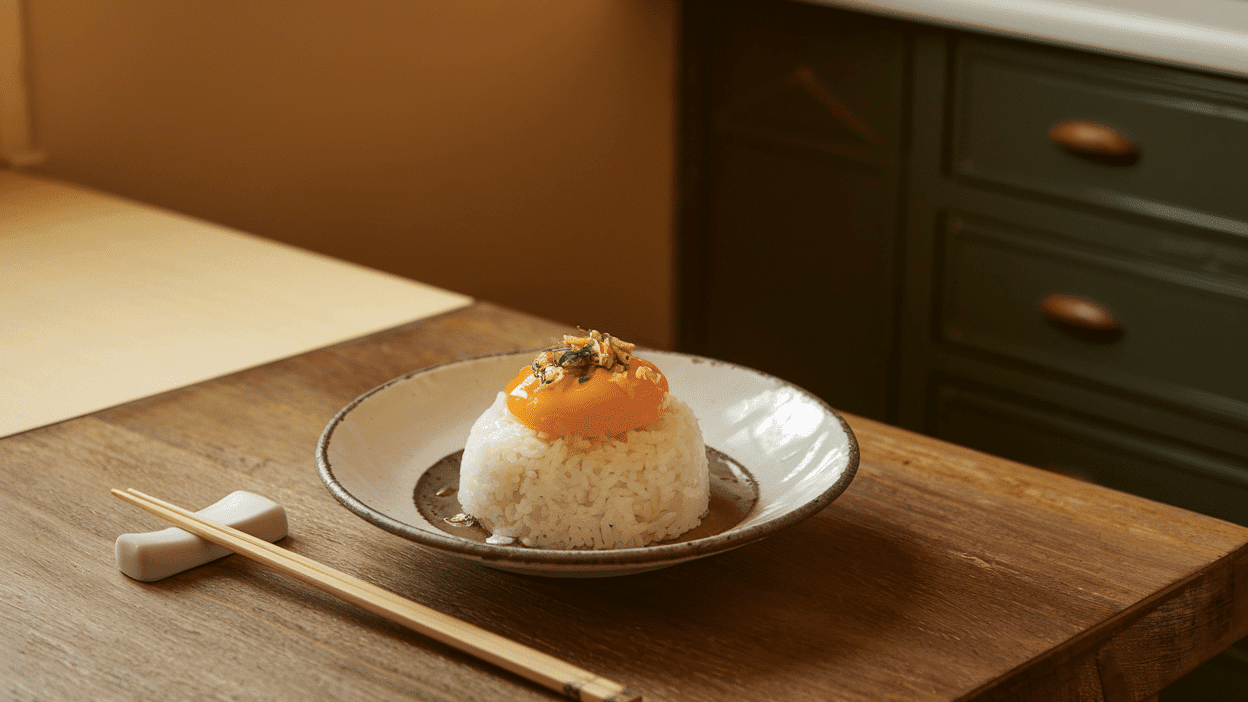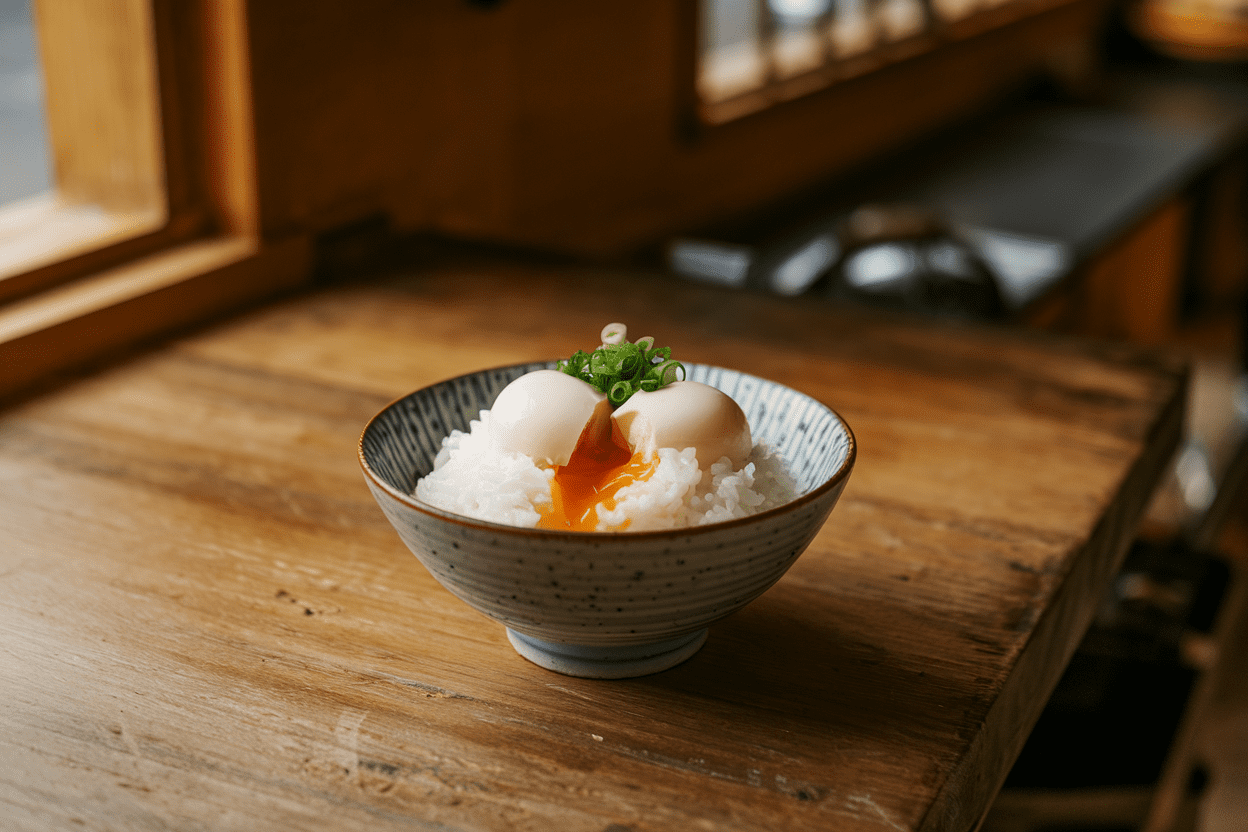After a long day, there’s something about the simplicity of a warm bowl of rice that feels incredibly comforting. Tamago Kake Gohan, a beloved Japanese dish, offers that soothing, homestyle appeal. It’s not just about the food—it’s about the nostalgia, the warmth, and the quick satisfaction that comes with every bite. Imagine cracking a fresh egg into a steaming bowl of rice, adding a dash of soy sauce, and stirring until the egg forms a silky coating around each grain of rice. This is Tamago Kake Gohan (卵かけご飯), and it’s as simple as it is satisfying.
In Japan, this dish is not just for breakfast; it’s a quick meal enjoyed at any time of the day. Whether you’re a student looking for a fast meal, a busy professional, or someone who craves comfort food after a hectic day, Tamago Kake Gohan is the answer. This recipe, despite its simplicity, can easily be transformed to fit your tastes and preferences, making it one of the most versatile dishes in Japanese cuisine.
Let’s take a deep dive into the world of Tamago Kake Gohan. From understanding its cultural significance to learning how to make the perfect bowl, you’ll be ready to enjoy this delightful dish in no time.
Table of Contents
What is Tamago Kake Gohan?
The Dish, the Tradition, and the Magic Behind It
Tamago Kake Gohan, translated as “egg over rice,” is one of Japan’s favorite comfort foods. As simple as it sounds, it’s a dish with a deep connection to Japanese home-cooking traditions. Made by mixing a raw egg with freshly steamed rice, this dish is often seasoned with soy sauce and enhanced with various toppings, such as nori (seaweed), sesame seeds, or green onions. The result? A creamy, savory meal that’s both filling and full of flavor.
But why does this simple dish hold such a special place in Japanese hearts? The answer lies in its comforting nature. Tamago Kake Gohan offers warmth, familiarity, and convenience. It’s easy to prepare, nourishing, and versatile. For many in Japan, it’s a nostalgic reminder of family meals or childhood moments. For others, it’s a quick fix when time or energy is in short supply.
Cultural Significance
Tamago Kake Gohan has been enjoyed for generations, often seen as a quick breakfast or a light meal. Its simplicity is part of its charm, and it reflects the Japanese philosophy of using minimal ingredients to create a dish that’s both satisfying and delicious.
Tamago Kake Gohan Recipe: Step-by-Step Guide
Now that you know what Tamago Kake Gohan is, let’s dive into the recipe itself. Don’t worry—it’s incredibly easy to make, and with a few tips, you’ll be a pro in no time.
Ingredients for Tamago Kake Gohan
To make Tamago Kake Gohan, you’ll need just a handful of basic ingredients. Here’s what you’ll need:
| Ingredient | Quantity | Notes |
| Fresh Japanese short-grain rice | 1 cup (steamed) | Best when warm, sticky rice is key for texture. |
| Raw egg (preferably free-range) | 1 egg | Fresh eggs are essential for the best flavor and safety. |
| Soy sauce | 1-2 tsp | Opt for a high-quality soy sauce for richer flavor. |
| Optional toppings: Nori, sesame seeds, scallions, wasabi | As desired | Add according to your preference. |

Instructions
- Prepare the Rice: Begin by cooking the rice. Japanese short-grain rice is preferred for its sticky texture, which allows the egg to coat the rice evenly. Once cooked, keep the rice warm for the best results. It should be just hot enough to cook the egg slightly when mixed.
- Crack the Egg: Carefully crack a fresh egg into the bowl of rice. If you’re concerned about consuming raw egg, you can use pasteurized eggs, which are a safer option.
- Mix the Egg with Rice: Using chopsticks or a spoon, stir the egg into the rice. The heat from the rice will slightly cook the egg, creating a creamy texture that clings to each grain. Stir until the egg and rice are thoroughly mixed.
- Add Soy Sauce: Drizzle 1-2 teaspoons of soy sauce over the rice and egg mixture. Adjust the seasoning to your liking, adding more if necessary. Soy sauce adds umami, a savory depth of flavor, making the dish more satisfying.
- Garnish (Optional): Add any toppings you like. Nori (seaweed) is a classic addition, as are sesame seeds, chopped green onions, or even a touch of wasabi for an extra kick. This step is where you can get creative and make the dish your own.
- Serve and Enjoy: Once your Tamago Kake Gohan is mixed and garnished, it’s ready to serve. Dig in and enjoy the simplicity and comfort that only a warm bowl of rice and egg can provide.
Why Tamago Kake Gohan is So Popular
The Allure of Simplicity and Comfort
There are many reasons why Tamago Kake Gohan is a staple in Japanese cuisine. Let’s explore a few of the key factors behind its lasting popularity.
- Quick and Easy: It takes just a few minutes to prepare, making it perfect for busy mornings or when you’re in need of a fast, satisfying meal.
- Affordable: The ingredients are simple and inexpensive, making it a budget-friendly choice for anyone, especially students or young professionals.
- Nutritionally Balanced: With a combination of protein from the egg and carbohydrates from the rice, Tamago Kake Gohan is a relatively balanced meal. You can also add toppings like vegetables or seaweed to further enhance its nutritional value.
- Nostalgic and Comforting: For many, Tamago Kake Gohan represents a connection to family traditions or childhood. The dish is often enjoyed in Japan as a comforting meal when you need a bit of familiarity and warmth.
Tamago Kake Gohan is more than just a meal—it’s a cultural touchstone. It reflects the Japanese focus on simplicity, quality, and the joy of everyday life.
Best Tips for Perfecting Tamago Kake Gohan
While the recipe itself is straightforward, there are a few tips to elevate your Tamago Kake Gohan to perfection.
- Fresh Eggs Are Essential: Always use the freshest eggs possible. Fresh eggs not only provide better flavor but are also safer to eat raw. Choose free-range or organic eggs for the highest quality.
- Use Short-Grain Rice: The texture of short-grain rice is key to achieving the perfect consistency in your Tamago Kake Gohan. Its stickiness helps the egg cling to the rice and gives the dish its signature creamy texture.
- Temperature Matters: The rice should be warm but not too hot. If it’s too cold, the egg won’t mix well. If it’s too hot, it will cook the egg too much and make it less creamy.
- Soy Sauce Quality: Choose a high-quality soy sauce, preferably one that’s brewed naturally. This will bring a deeper, more complex flavor to the dish.
- Toppings Are Your Choice: The beauty of Tamago Kake Gohan is that you can customize it. Add a sprinkle of sesame seeds, some nori strips, or a dash of chili oil to give it your own unique twist.
Tamago Kake Gohan Variations You Must Try
While the basic recipe is simple, you can make this dish even more exciting by adding a few extra ingredients. Here are some popular variations of Tamago Kake Gohan that you can try:
- Mentaiko (Cod Roe) Tamago Kake Gohan: Mentaiko adds a rich, slightly spicy flavor that pairs wonderfully with the creaminess of the egg.
- Kimchi Tamago Kake Gohan: Add some chopped kimchi to your rice for a tangy, spicy twist. The fermented flavors of kimchi add an extra layer of complexity.
- Avocado Tamago Kake Gohan: For a creamy, modern touch, top your Tamago Kake Gohan with slices of fresh avocado. The mild flavor of avocado complements the egg beautifully.
- Wasabi Tamago Kake Gohan: If you like a bit of heat, a small dab of wasabi can bring a sharp kick that balances the richness of the egg and rice.
Frequently Asked Questions (FAQ)
Q1: Can I eat Tamago Kake Gohan for breakfast?
Absolutely! Tamago Kake Gohan is traditionally enjoyed as a breakfast dish in Japan. It’s quick, satisfying, and provides the energy you need to start your day.
Q2: Is it safe to eat raw egg in Tamago Kake Gohan?
While eating raw egg carries a slight risk of foodborne illness, you can reduce this risk by using pasteurized eggs or eggs from a trusted source. Many Japanese eggs are specifically farmed for raw consumption.
Q3: How can I make Tamago Kake Gohan vegan?
To make a vegan version, substitute the egg with a plant-based egg alternative (like tofu) and use vegan soy sauce. You can also top it with avocado for extra creaminess.
Q4: What type of rice is best for Tamago Kake Gohan?
Short-grain rice is ideal because of its sticky texture, which makes the egg mixture cling to the rice and creates that signature creamy consistency.
Conclusion: Savor the Simplicity of Tamago Kake Gohan
Tamago Kake Gohan is more than just a meal; it’s a reflection of Japan’s culinary tradition—simple, comforting, and satisfying. Whether you’re looking for a quick breakfast, a late-night snack, or a reminder of the comforts of home, this dish delivers it all. By using just a few basic ingredients, you can enjoy a meal that’s both nourishing and full of flavor.
So why not give this Tamago Kake Gohan recipe a try? With endless variations to suit your taste, this dish is ready to become a part of your regular cooking routine. Enjoy!

